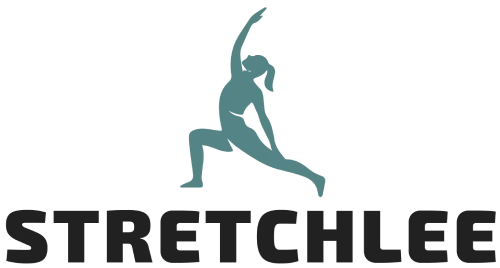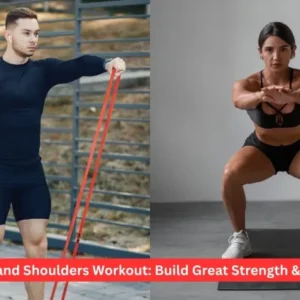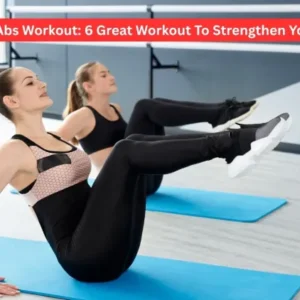The best type of exercise to warm up is stretching before abs workout, as it helps improve core strength and flexibility while reducing injury risk. Stretching before a workout helps improve your core strength and flexibility, reducing the risk of injuries.
For that reason, we came up with a simple list of the best ways to stretch your abdominal muscles while you recover. There are descriptions and videos for 8 stretches, making it easier to perform them correctly.
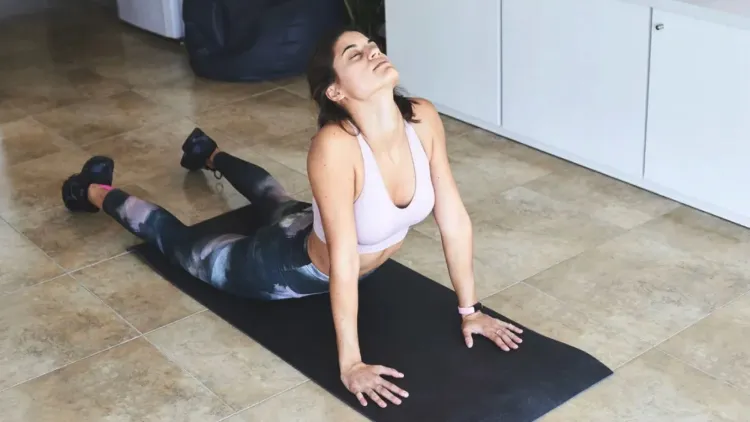
Stretching before abs workout: 5 Top Stretches
1. Side abdominal stretch
This is one of the best exercises for stretching before abs workout—it’s effective, easy to do anywhere, and targets your core. Just set aside some adequate space and rely on yourself. Even though this section can be done quickly, it remains very effective.
First, pick a spot and place your feet apart by your shoulders. Hold your arms to your sides.
Execution:
- Put your right arm up while leaving your left arm at your side. At first, lower yourself to the left as you put your left arm out to your side.
- In this position, you need to feel your obliques being stretched.
- Get back to the starting place and extend your arms to let your hands hang loose at your sides.
- Again, stretch your abdomen, this time with your left arm raised towards the ceiling.
- Substitutions should be done every 10 seconds for each team.
- The movements target the Obliques, the Abdominals, and the Serratus Anterior.
Common Mistakes to Avoid
- Overstretching the area: Pushing yourself too hard may result in injury or a pull of the muscles in your obliques. Try to stretch just to the point where you feel the tension, and back off when you experience any type of pain.
- Sitting position: You have to get into the proper seat for this stretch. Holding your feet apart in a pose may put a lot of strain on your knees and legs. The reason for this stretch is to build your core, not your legs; therefore, if you feel pain, please recheck that you are doing the stretch properly.
- Stretch the whole body, not only the core; arm exercises can be carried out after you stretch your whole body.
2. Supine Stretch
It is ideal for winding down a workout since you stay lying on a mat instead of getting up, which saves your energy.
Take the exercise by having a mat behind you, making it more comfortable for you. Lying down on your back with your arms stretched straight over your head comes next.
How to:
- You should lie flat on your back to start this exercise.
- After that, bring your arms straight up and focus your fingers away from you.
- Straighten your torso and your arms away from your head.
- At this moment, I instruct the robot to time the next action for 10 seconds.
- Exercises work the abdominals, chest, and the latissimus dorsi.
Common Mistakes to Avoid
- Doing this Stretch in a way that over-stretches your stomach muscles can cause distress in your back and raise your chances of injuring your back. Don’t stretch to the point where pain sets in, but just until you slightly feel that you are stretching. Should you detect any pain, stop immediately and check how you are doing your technique.
- Over-arching back movement greatly stretches the abs, though you need to be careful to do it accurately. Arching your back adds too much stress to your core, thighs, and hamstrings.
- The next problem with this abdominal stretch is that many people wrongly bring their toes flat or horizontal, instead of keeping them pointing straight upward. Always try to flex your feet during this exercise so you don’t place excess pressure on your back and legs.
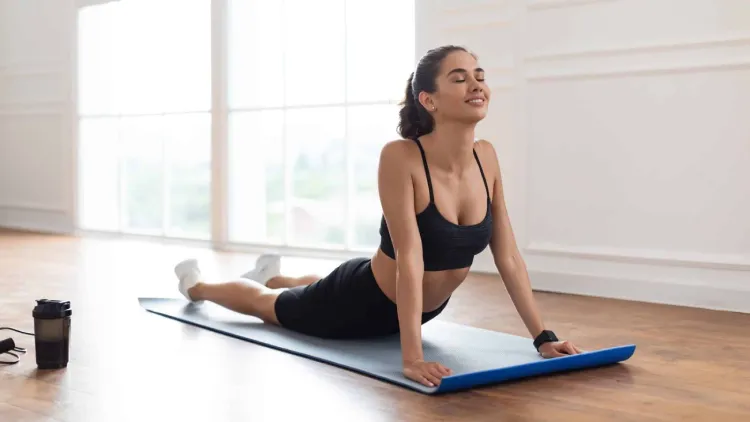
3. Snake Stretch
If you have little flexibility, the snake stretch is a fine way to stretch your abs and relax.
Get a mat for your comfort, then go into the starting position as shown. Put both palms down on the floor beyond your shoulders, keeping your elbows at a right angle.
Execution:
- Stretch out your body with your stomach facing down and place your hands on either side of your shoulders, with palms going towards the floor and elbows bent right angle. Make certain that your toes are not curled and your feet lie flat on the ground. With your hands on the floor, push up and lift your torso so that you can feel a stretch in your abs.
- Be sure to keep your head in a position that is not bent forward.
- It takes 10 seconds for the process to complete.
- The abdominals, trapezius, spinal erectors, and rear deltoids are worked during the movement.
Common Mistakes to Avoid
If you have little flexibility, the snake stretch is a fine way to stretch your abs and relax.
Get a mat for your own comfort, then go into the starting position as shown. Put both palms down on the floor beyond your shoulders, keeping your elbows at a right angle.
Execution:
- Stretch out your body with your stomach facing down and place your hands on either side of your shoulders, with palms going towards the floor and elbows bent right angle. Make certain that your toes are not curled and your feet lie flat on the ground. With your hands on the floor, push up and lift your torso so that you can feel a stretch in your abs.
- Be sure to keep your head in a position that is not bent forward.
- It takes 10 seconds for the process to complete.
- The abdominals, trapezius, spinal erectors, and rear deltoids are worked during the movement.
4. Slow Cyclone Abs
You will feel more flexible after this stretch, so it is a good warm-up for tough exercises!
First Step: Make sure there is plenty of room for your body as you do this stretch. Therefore, keep your feet slightly apart and bend your legs to ensure they are not stiff.
Execution:
- Position your back straight and raise both your arms up overhead.
- Swing your upper body around your hips to make your torso move in a spin.
- Both your arms and your torso should be lined up as you do this stretch and move continuously.
- 15 seconds is needed for it.
- Abdominals, Obliques, and Serratus Anterior are the muscles used in this movement.
Common Mistakes to Avoid
- When you bend your knees too much, you place a lot of extra strain on your legs, mainly on your knees, and this can lead to pain and soreness. In this way, you can easily make the stretch harder and shorter, so it doesn’t do its job as well.
- Overdoing side-to-side movement can strain the sides of your abs and increase the chances of an injury during this stretch. Rather, do the movements in a loose, round, and dreamy way.
- Look into the best-paid positions in the fitness industry by reading about them.
5. Locust Pose
The locust abdominal stretch is a good choice before a workout because it helps pump up your heart rate and prepares you for your session. The strength of this stretch can be changed depending on how long you keep it.
Make sure you are comfortable by placing a mat when doing this abdominal stretch. Get down to the floor and place your stomach towards it as you lie down.
How to Perform
- Place your belly on the ground as your arms and legs stretch away from your body to the sides. Having your back rounded, raise your chest upward and your legs outward in a boat position. Slowly stand up and get back in position.
- 10 seconds were required for this process.
- Chest Fly works the Trapezius, Rear Deltoid, Triceps, Latissimus Dorsi, the Trunk muscles, Glutes, Soleus, Biceps Femoris, Vastus Lateralis, and the Erector Spinae.
Mistakes You Should Try to Avoid
- Don’t let your arms go forward: Stretching your arms in front makes a different type of stretch and is bad for your chest. Instead, keep your palms facing up while keeping your arms down at your side.
- Try to avoid curling your feet when you hold this stretch. This is a mistake some people make during this abdominal stretch. Try to face the tops of your feet upwards and ensure that all your weight is balanced and there is no discomfort in your feet.
- Besides stretching your abs, the locust pose is one of the most popular yoga poses.
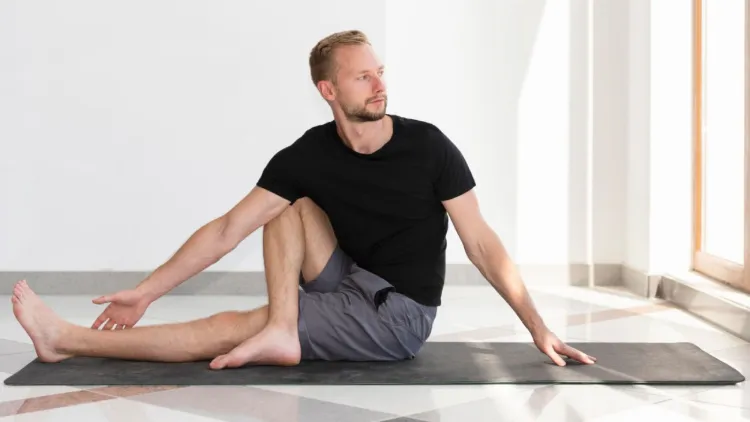
Conclusion
By now, you know that stretching before abs workout is essential for easing tension, preventing DOMS, and safely building six-pack abs. Stretching before abs workout is key to preparing your muscles and preventing injury.
After exercising, your abs need attention, so our guide and videos tell you how to stretch them with simple steps. If fitness is something you love, and you want to become a personal trainer, you can find out about our training diploma on our website and set yourself up for the industry.
Frequently Asked Questions
Why is stretching before abs workout important?
Stretching before abs workout helps increase blood flow to your core muscles, improves flexibility, and reduces the risk of injury during your training session. It makes your abdominal muscles stronger and ready for improved performance.
How long should I spend stretching before abs workout?
Aim for 5-10 minutes of targeted stretching before abs workout. This way, you are able to exercise your core muscles for a reasonable time without tiring them before you do your main workouts.
Can I skip stretching before abs workout?
While possible to skip stretching before abs workout increases your risk of muscle strains and decreases your range of motion. Light stretching for only a couple of minutes every day is better than not stretching at all.
What are the best stretches to start your abs fitness?
You can try the side abdominal stretch, the supine stretch, and the locust pose as they are the safest moves for abs workouts.
